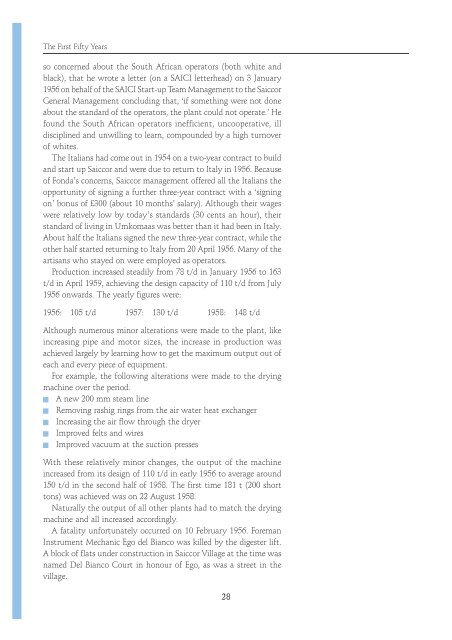You also want an ePaper? Increase the reach of your titles
YUMPU automatically turns print PDFs into web optimized ePapers that Google loves.
<strong>The</strong> <strong>First</strong> Fifty <strong>Years</strong><br />
so concerned about the South African operators (both white and<br />
black), that he wrote a letter (on a SAICI letterhead) on 3 January<br />
1956 on behalf of the SAICI Start-up Team Management to the <strong>Saiccor</strong><br />
General Management concluding that, ‘if something were not done<br />
about the standard of the operators, the plant could not operate�’ He<br />
found the South African operators inefficient, uncooperative, ill<br />
disciplined and unwilling to learn, compounded by a high turnover<br />
of whites�<br />
<strong>The</strong> Italians had come out in 1954 on a two-year contract to build<br />
and start up <strong>Saiccor</strong> and were due to return to Italy in 1956� Because<br />
of Fonda’s concerns, <strong>Saiccor</strong> management offered all the Italians the<br />
opportunity of signing a further three-year contract with a ‘signing<br />
on’ bonus of £300 (about 10 months’ salary)� Although their wages<br />
were relatively low by today’s standards (30 cents an hour), their<br />
standard of living in Umkomaas was better than it had been in Italy�<br />
About half the Italians signed the new three-year contract, while the<br />
other half started returning to Italy from 20 April 1956� Many of the<br />
artisans who stayed on were employed as operators�<br />
Production increased steadily from 78 t/d in January 1956 to 163<br />
t/d in April 1959, achieving the design capacity of 110 t/d from July<br />
1956 onwards� <strong>The</strong> yearly figures were:<br />
1956: 105 t/d 1957: 130 t/d 1958: 148 t/d<br />
Although numerous minor alterations were made to the plant, like<br />
increasing pipe and motor sizes, the increase in production was<br />
achieved largely by learning how to get the maximum output out of<br />
each and every piece of equipment�<br />
For example, the following alterations were made to the drying<br />
machine over the period�<br />
A new 200 mm steam line<br />
Removing rashig rings from the air water heat exchanger<br />
Increasing the air flow through the dryer<br />
Improved felts and wires<br />
Improved vacuum at the suction presses<br />
With these relatively minor changes, the output of the machine<br />
increased from its design of 110 t/d in early 1956 to average around<br />
1<strong>50</strong> t/d in the second half of 1958� <strong>The</strong> first time 181 t (200 short<br />
tons) was achieved was on 22 August 1958�<br />
Naturally the output of all other plants had to match the drying<br />
machine and all increased accordingly�<br />
A fatality unfortunately occurred on 10 February 1956� Foreman<br />
Instrument Mechanic Ego del Bianco was killed by the digester lift�<br />
A block of flats under construction in <strong>Saiccor</strong> Village at the time was<br />
named Del Bianco Court in honour of Ego, as was a street in the<br />
village�<br />
28

















